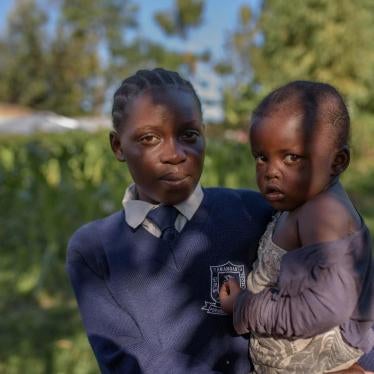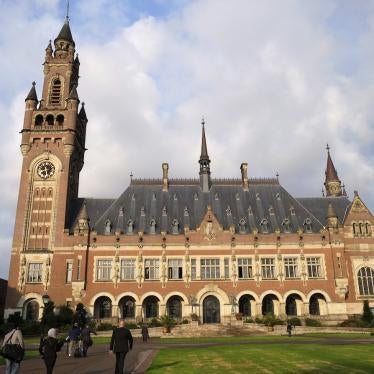(New York) – Egypt’s civilian government should order a halt to any immediate plans to disperse the two Muslim Brotherhood sit-ins in Cairo by force and deal peacefully with any problems arising. The authorities should respect the rights of all to peaceful assembly.
On July 31, 2013, the government authorized the interior minister to “take all necessary measures” to “confront violence and terrorism” in the sit-ins, but did not elaborate what those measures would be. In dealing with protests, Egypt’s security forces have regularly resorted to excessive use of force, killing at least 137 people in the past month alone.
“To avoid another bloodbath, Egypt’s civilian rulers need to ensure the ongoing right of protesters to assemble peacefully, and seek alternatives to a forcible dispersal of the crowds,” said Nadim Houry, deputy Middle East director at Human Rights Watch. “The police’s persistent record of excessive use of force, leading to dozens of deaths this month, and the density of the sit-ins mean that hundreds of lives could be lost if the sit-in is forcibly dispersed.”
As a state party to the International Covenant on Civil and Political Rights and the African Charter on Human and Peoples’ Rights, the Egyptian authorities are required to protect and ensure the right to assemble peacefully. This means they must facilitate demonstrations and ensure they can take place peacefully.
Any restrictions imposed must be for a legitimate aim, nonarbitrary, and according to law. And any restrictions may not discriminate on grounds such as political belief, and must be necessary and proportionate to the aim pursued. Prohibition of any particular demonstration, including dispersal, must be a last resort. Imposition of restrictions and bans on demonstrations should be subject to appeal before an independent and impartial court.
Under international law, the overall duty to ensure the right to peaceful assembly means that state authorities may not treat an entire demonstration as violent due to the acts of a few participants, Human Rights Watch said. The authorities may not punish peaceful protesters for crimes committed by individual protesters or for possession of unlicensed weapons by some protesters.
Human Rights Watch visited the two main protest sites, in Rab’a al-Adawiya and al-Nahda square, both of which were densely populated with women, children, and men who have been staging a month-long sit-in to protest the removal of President Mohammed Morsy.
Over the past weeks, some residents of the buildings surrounding the sit-in in Rab’a al-Adawiya have filed formal complaints because of their inability to easily access their building entrances. Media reports have circulated claiming some Morsy supporters abused individuals they suspect of being “infiltrators” of the sit-in. Witnesses have reported seeing protesters armed with guns at the Giza sit-in. Human Rights Watch interviewed one man who said he and a group of men grabbed and detained another man under the Nahda stage along with eight other captives, as well as a boy who said protesters at Nahda beat him, subjected him to electric shocks, and cut him with bladed weapons.
Deadly clashes took place in the neighborhood of the Nahda sit-in between Muslim Brotherhood supporters and residents. On July 5 in the neighborhoods of Manial, and on July 2 in Bein al-Sarayat, protesters clashed with residents of local neighborhoods for several hours, leaving 22 dead, but police failed to intervene and end the violence.
The authorities should investigate criminal allegations, but the actions of individual protesters do not provide sufficient justification for a forcible dispersal, Human Rights Watch said. A forcible dispersal would violate the right of others to assemble and endanger the lives of the thousands of other peaceful protesters present at the sit-in, Human Rights Watch said. Instead, security officials should deal with crimes committed and any inability of residents to access their homes in a proportionate manner.
The Egyptian authorities are required to take the utmost care in the choice of means and methods employed by its security services when confronting or dispersing a protest. The authorities must ensure that thorough planning takes place before any operation is carried out and then ensure that the operation is carried out in a way that minimizes harm or any risk to life. This planning should include giving advance notice to protesters so they can respond to dispersal requests by the security forces.
On July 31, citing a popular mandate to “fight violence and terrorism,” the Egyptian cabinet authorized the interior minister to “take all necessary measures to face these dangers and put an end to them within the framework of the constitution and the law.” Egyptian law provides overly broad discretion to the police in the dispersal of protests and the use of force and firearms and therefore does not sufficiently protect the right to life, Human Rights Watch said. Later that day, Interior Minister Mohamed Ibrahim told the Associated Press that the ministry would use gradual steps such as “a warning to leave the area, use of teargas if protesters don’t leave, and finally ‘legitimate self-defense.’”
Human Rights Watch and other organizations have documented numerous occasions in recent years in which Egypt’s riot police have consistently responded with excessive and unlawful lethal force in dispersing demonstrations that grow violent.
“Given the level of tensions between the protesters and the police, the numbers and presence of women and children in a confined space, and the police’s record in crowd dispersal, there is a substantial risk that any forceful actions by the police will end in a terrible loss of life,” Houry said.
Political leaders in the sit-in should urge their followers to exercise restraint and call for protesters to refrain from any form of violence.
The presence of certain violent elements in a gathering do not justify treating the entire protest or sit-in as violent. The UN’s first special rapporteur on the rights to freedom of peaceful assembly and of association, Maina Kiai, published his first general report in May 2012, to highlight best practices in the protection of these rights. In it he cited a European Court of Human Rights case that states that, “an individual does not cease to enjoy the right to peaceful assembly as a result of sporadic violence or other punishable acts committed by others in the course of the demonstration, if the individual in question remains peaceful in his or her own intentions or behavior.”
He stressed the overwhelming importance of the right to life in policing assemblies and “stresses the utmost importance of genuine dialogue, including through negotiation, between law enforcement authorities and organizers in order to ensure the smooth conduct of the public assembly.”
Egypt’s police law and interior ministry regulations grant the police overly broad discretion in the use of live gunfire in the vicinity of police stations or during the policing of demonstrations. Article 102 of the 1971 Police Law No. 109 provides the police with powers to use firearms that go beyond what international law permits. It permits the police to fire on “crowds” of more than five people if they “threaten public security,” a much broader standard than under international law, which requires a “particularly serious crime involving grave threat to life.”
The government should publicly order the security forces to follow the UN Basic Principles on the Use of Force and Firearms by Law Enforcement Officials, which state that security forces shall “apply non-violent means before resorting to the use of force and firearms,” and that “whenever the lawful use of force and firearms is unavoidable, law enforcement officials shall: (a) Exercise restraint in such use and act in proportion to the seriousness of the offence and the legitimate objective to be achieved; (b) Minimize damage and injury, and respect and preserve human life.”
The UN Basic Principles on the Use of Force and Firearms by Law Enforcement Officials state in principle 13 that:
In the dispersal of assemblies that are unlawful but non-violent, law enforcement officials shall avoid the use of force or, where that is not practicable, shall restrict such force to the minimum extent necessary.
And in the case of violent assemblies, principle 14 states that:
Law enforcement officials may use firearms only when less dangerous means are not practicable and only to the minimum extent necessary. Law enforcement officials shall not use firearms in such cases, except under the conditions stipulated in principle 13.
All security authorities and in particular their commanders are bound to respect the right to life of all. That includes planning and ordering all operations so that the risk to life is minimized, all forces respect the basic principle that intentional lethal force may only be used when strictly necessary to protect life, and anyone who violates these rules, by unlawful killing, complicity or ordering unlawful killing, or negligently failing to prevent such killing, is held accountable.
“The Egyptian cabinet should be doing its utmost to deescalate the situation and give negotiations with the protesters a chance, and should not pursue a brinkmanship policy that is likely to lead to more deaths and anger,” Houry said. “The best way to handle the sit-ins is to begin talks.”






